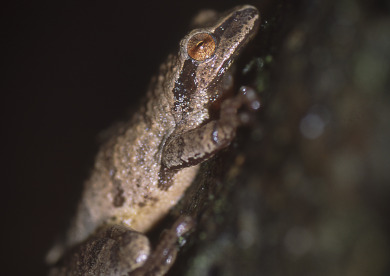It’s a warm spring evening. The sun has set. Down in the valley, there is a chorus erupting, and up on the hill in a pond, another is just beginning. The spring peepers are in stereo. Spring has finally sprung.
The cacophony is emanating from hundreds of male spring peepers. Each peep is made when a frog forces air from its lungs, over the vocal cords in the larynx, and into an air sac in its throat. The air enters the sac from openings on each side of the mouth cavity, causing the sac to balloon outward. The inflated sac acts as a sounding board, amplifying the sound and carrying it from the frog to my ears across the valley.
What sounds like chaos to me sounds organized to a peeper. Several males may interact vocally by forming duets, trios, or quartets, with alternating peep calls and individual notes. When males alternate calls, one individual, the follower, usually calls within 40 to 70 milliseconds from the end of the leader’s call.
Males tend to stay within a close pitch range of each other. The spacing and timing of calls accentuates the distinctiveness of each male’s call so that it is not lost in the overall din and allows a female to zero in on a single calling male. When another male frog moves too close, one male may use a second type of call, a trill. The trill seems to reflect a higher degree of aggression than the peep call and will stimulate one of the individuals either to move away or perhaps to trill back in challenge, causing a trill-off. A trill-off can escalate into a brief physical scuffle, with the winner staying and the loser moving on to quieter waters.
Each male peeper can pump out from 3,000 to 4,000 peeps an hour for several hours each night. So it is not surprising that male trunk muscles, which help propel air from the lungs, average 15 percent of their body mass compared to only 3 percent for the quiet females. Aerobic capacity of trunk muscle is six times that of leg muscles and, in males, is 17 times greater than that of female trunk muscle. Peepers derive about 90 percent of their energy for call production from fat reserves in these muscles. Males weigh on average about the same as two dimes, yet their sound pressure is comparable to the song of a warbler (about 4 quarters in weight) or a blackbird (a whopping eight half-dollars in weight). These little peepers have big bellows.
The peeper mating system is based on female choice. The louder and faster he peeps, the better his chances of attracting a receptive female. When biologists played recorded peep calls for female peepers, the females preferred peep rates double those found in the wild, indicating a strong sexual selection for males that can peep fast. Male peepers, therefore, push their singing abilities to the limit, performing at or close to their full physiological capacity. But one night of binge calling doesn’t seem to wear them out: males that have the higher peep rates in one night tend to have higher peep rates every night.
The evening temperature can affect calling patterns. On warmer evenings, peepers call much more frequently. The consumption of oxygen increases with calling rate, which in turn increases with temperature. At a balmy 60°F, peep calls are repeated up to 13,500 times per night.
Not all males sing, though. A big chorus of singers will also attract a host of silent males, who mix in around the edges. These shy guys tend to be smaller than the big singers. They quietly wait near a good singer, watching for a female that may be attracted to a peeping male. When she comes along, they use their quickness and agility to beat the singer to the female.
According to the Vermont Amphibian and Reptile Atlas, peepers can begin calling as early as March 15, with peak activity in early May. Chances are good that the spring peeper chorus is now happening earlier than in the past, according to a study by James Gibbs, from the State University of New York in Syracuse, and Alvin Breisch, of the New York Department of Environment Conservation.
From 1900 to 1912, Albert Wright, an instructor in zoology at Cornell University, visited ponds around the campus daily each spring to record the date of the first calls of frogs. Ninety years later, volunteers collected the same kind of information for the New York Amphibian and Reptile Atlas, allowing Gibbs and Breisch a chance to compare. Wright, on average, heard his first peepers on April 4. Atlas volunteers heard them around March 20, about 13 days earlier.
For us, it is spring music to our ears. For the peepers, it is a singing battle of life and death. I hope their spring tradition goes on and on.


Love the sound!!